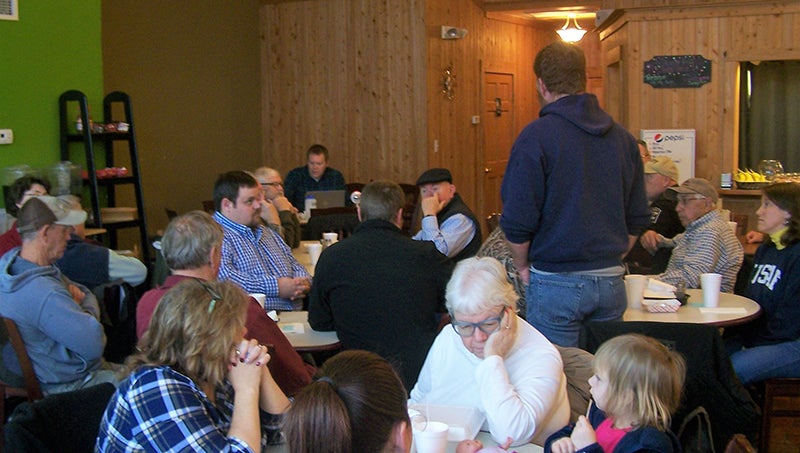Tyrrell landowners turn thumbs down on red wolf program
Published 2:11 pm Friday, March 1, 2019

- Dr. Ron Sunderland, with the Wildlands Network, (facing, background), conducted a red wolf listening session in Sandy's Place in Columbia on Feb. 23. Most speakers, such as Greg Comstock (standing), continue to oppose the federal program. (R. McClees photo)
Most local residents continue to oppose the federal government’s red wolf recovery program in this area, judging from comments during a red wolf listening session in Columbia on Feb. 23.
Dr. Ron Sutherland of Durham, chief scientist for the Wildlands Network, and Kim Wheeler of Columbia, exeuctive director of the Red Wolf Coalition, hosted the 9 AM listening session, including free breakfast, in Sandy’s Place restaurant on Main Street.
Both men and women gave examples of pet or barnyard animal losses, seeing fewer deer and other wildlife, and family members being frightened by red wolves in their yards.
Roger Hudson claimed that the only way to sustain wildlife for hunting purposes “is to get rid of predators — red wolves and coyotes.”
Joe Landino, who said he has had no problem with the red wolf, called for an end to the federal program. “Since it’s impossible to remove them, just leave them alone and let nature take its course.”
Landino said his trail camera south of Columbia recorded “50 to 60 images of coons, foxes and bobcats” out of 100 exposures.
George Haislip stated that his trail cameras in Alligator community and at his Colonial Beach residence “show a strong animal population and strong mix, including hundreds of deer images.”
David Gallop charged there is no one at the Fish and Wildlife Service (red wolf recovery program administrators) to “interact with or call when there’s a problem. Red wolves are killing deer, and eating watermelons in gardens, and there’s no FWS outreach. Red wolves are a liability on my land, and I don’t think the program can be fixed.”
Sandra Owens, local taxidermist, said she has trouble distinguishing a red wolf from a coyote, the former being protected and unlawful to mount.
The hosts declined to answer questions about the red wolf program or debate its merits. The meeting lasted about 45 minutes, after which lucky ticket holders, among the more than 40 who attended, won six door prizes donated by local businesses.
The U.S. Fish and Wildlife Service has announced it will shift the Red Wolf Recovery Program’s focus and resources onto federal lands in Dare County. Additionally, the Service will manage the species as a single entity, encompassing both the captive population managed under the SSP and the non-essential, experimental wild population in northeastern North Carolina.
“The September 1987 release of red wolves into the Alligator River National Wildlife Refuge marked the first time in this Nation’s history that a federally-listed species was reintroduced to the historical range from which it had been extirpated,” The FWS explained. “The Service has learned a great deal about the red wolf from the non-essential, experimental population. … Wild-born red wolves have the best chance of surviving and successfully establishing territories and reproducing. As such, the Service is proposing to manage a smaller wild population in North Carolina.”
FWS’s current population estimate is 45 individual red wolves that include 28 with radio collars and one with a satellite collar. “Overall, this population consists of five packs and three known breeding pairs, widely distributed across Beaufort, Dare, Hyde, Tyrrell and Washington counties.”
Below is a link to the Wildlands Network’s flickr site showing trail camera photos from Alligator River and Pocosin Lakes National Wildlife Refuges:
www.flickr.com/photos/redwolfreality/albums

